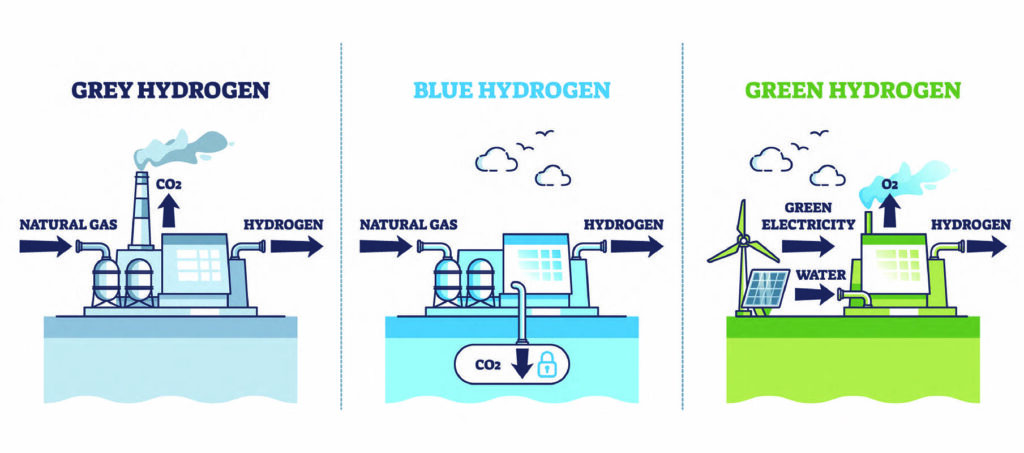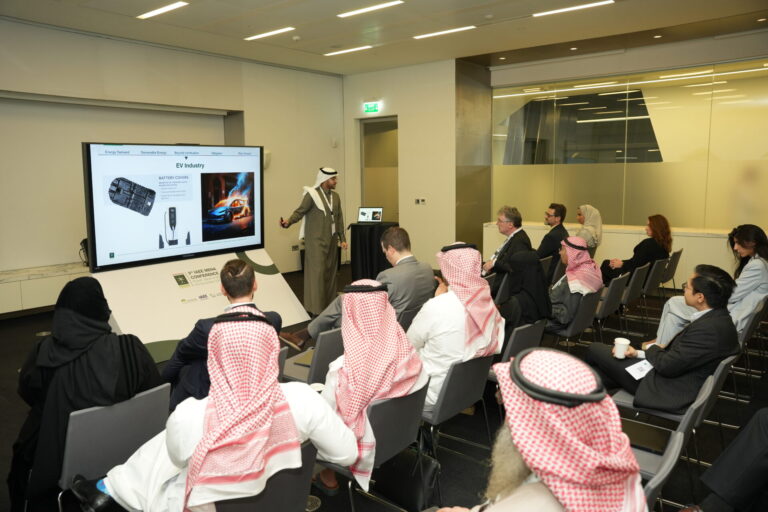Clean hydrogen is poised to play a pivotal role in the transition to a decarbonized energy sector, potentially accounting for almost a quarter of energy consumption by 2050, according to international energy roadmaps. However, hydrogen’s contribution in the current mix is minimal. Meeting the 2050 target will require a very rapid ramp-up in clean hydrogen production.
KAPSARC researchers Rami Shabaneh and Wolfgang Heidug highlight the potential of ‘blue hydrogen’ as crucial bridge during this transition phase. Blue hydrogen cleans up the existing industrial process of hydrogen production from fossil fuels — a process responsible for 2% of global CO2 emissions—by combining it with carbon capture and storage (CCS). This approach can significantly reduce emissions, making it a more sustainable option.
A key advantage of blue hydrogen compared to other fuels, including other forms of clean hydrogen, is that the core process is already in industrial use. “Blue hydrogen production relies on mature and proven technologies that can be readily available at the required scale,” Shabaneh says. “To meet the goals of the Paris Agreement on time and in a cost-effective manner, the development of a fully operational clean hydrogen infrastructure is only likely to succeed with blue hydrogen as part of the equation.”
Despite the technological maturity, significant barriers still hinder rolling out blue hydrogen. A key hurdle is the absence of international standards and documentation systems to certify that the CO2 generated during blue hydrogen production is securely captured and stored. “Certification is a significant roadblock for blue hydrogen development,” Heidug says.
Leveraging KAPSARC’s deep experience and international leadership in carbon capture and storage policy development, Shabaneh and Heidug have analyzed this potential roadblock to blue hydrogen development and proposed a roadmap toward its certification. Their proposal is designed to accelerate the development and implementation of international blue hydrogen standards by separately certifying the hydrogen production and the carbon storage elements of the process.
Transition lines
Blue hydrogen could pave the way for other forms of clean hydrogen. In the long-term, the future of clean hydrogen probably lies in green hydrogen, which is produced through the electrolysis of water powered by renewable electricity. However, green hydrogen electrolyzer technology remains immature and unproven at scale. “Green hydrogen pathways also require substantial amounts of newly installed renewable electricity,” Heidug says.
In the short to medium term, blue hydrogen could fill the gap while also bolstering international carbon emission reduction efforts more broadly, Heidug notes. “Blue hydrogen supports the development of geological CO2 storage sites,” he says. These sites could store CO₂ not only from hydrogen production, but also from hard-to-abate sectors such as steel and cement production, as well as from direct air capture and bioenergy with carbon capture and storage. “These technologies can provide for negative emissions, which are needed to reach the 2° stabilization target of the Paris Agreement,” Heidug says.
“While blue hydrogen can currently compete with green hydrogen on cost, it must also compete in emissions performance to enable decarbonization.”
Rami Shabaneh
Advancing blue hydrogen also shows how the hydrocarbon industry’s expertise in large-scale CO2 storage can play a key role in driving practical solutions for the energy transition. “This reinforces the commitment of fossil-fuel-exporting signatories to the Paris Agreement, including the MENA countries but also Australia and the US,” says Shabaneh.
International standards
“While blue hydrogen can currently compete with green hydrogen on cost, it must also compete in emissions performance to enable decarbonization,” explains Shabaneh. “This requires hydrogen production with high CO2 capture rates and low methane-intensity sourced natural gas.”. It also requires the secure and reliable long-term geological storage of the gas, and the certification of capture and storage to evidence that the hydrogen meets predefined environmental standards.
“KAPSARC has longstanding leadership in policy discussions related to securing safe and permanent geological CO2 storage,” Heidug says. “In 2019, for example, we hosted a workshop with participants from organizations such as the OECD, World Bank, UNFCCC Secretariat, Shell, Aramco and the Saudi Ministry of Energy to discuss policies that could incentive geological CO2 storage.” One idea generated during that meeting was the introduction of a carbon storage unit (CSU), as evidential proof that a unit of CO2 has been stored permanently in geological storage site.1 “This idea is very close to the certification concept that we now propose for blue hydrogen,” Heidug says.

In their latest work, Heidug and Shabaneh reviewed the current situation on hydrogen certification and highlighted a potential pathway. Surveying the field’s nascent efforts to certify clean hydrogen projects, the team identified significant disparities between jurisdictions, which potentially could impede the emergence of an international blue carbon market.
“In the absence of harmonized, internationally recognized certification systems, countries have adopted different criteria for assessing blue hydrogen’s cleanliness,” Heidug says. “This could lead to market fragmentation, hampering international trade and creating investor uncertainty, slowing down the global expansion of clean hydrogen.”
Currently, some countries use color codes—green, blue and gray—to classify hydrogen based on production methods, while others focus on the hydrogen’s carbon content regardless of the production process. Additionally, there were differences in the methodologies for calculating the emissions of the process, including whether to include upstream emissions in the calculations, such as methane leakage during natural gas extraction.
An international framework that could form the basis of a more unified approach does exist, Shabaneh notes. “There is an ISO standard available—ISO 19870—that addresses some of these divergences,” he says. This standard could provide the basis for the ‘surface certification’ aspect of hydrogen production, quantifying the carbon footprint across the entire value chain, from natural gas sourcing, followed by the transportation and processing of natural gas and the production of hydrogen, and ending with hydrogen use.
“However, the geological storage aspects for the blue hydrogen pathway production pathway falls out of the remit of this standard,” Shabaneh says. “While its adoption would reduce barriers for hydrogen trade, the permanence of geologic storage must be addressed. To achieve this requires a novel collaborative structure.”
Certifying storage
Rather than try to incorporate storage and form a single certification process for blue hydrogen certification, a clear pathway forward would be to separately certify the carbon storage aspect of blue hydrogen production, the KAPSARC team has proposed. “Separating the ‘surface components’ from the ‘geological storage’ component is beneficial, as they serve different purposes,” Heidug says.
Existing international regulatory initiatives for geological carbon storage, including those developed by the IPCC and UNFCCC, could form the basis of this part of blue hydrogen process, Heidug suggests. This approach could support carbon abatement efforts beyond blue carbon, he adds. Once a storage site has been certified as part of the blue hydrogen certification process, it would not require re-certification if the site were also used to store CO₂ from other sources. “This is a significant advantage of the two-part certification process,” Heidug says.
Currently, many jurisdictions underestimate the importance of standardized blue hydrogen certification, Shabaneh notes. “Our analysis argues for decisive action for blue hydrogen certification and outlines the general direction needed to develop such a certification system,” he says. The KAPSARC team is completing an in-depth analysis into the types of cooperation necessary to build global markets for clean hydrogen. “It is our hope that this message is heard and that a country steps forward to take a leadership role in these efforts,” Heidug says.
Reference
Zakkour, P. D., Heidug, W., Howard, A.,Haszeldine, R. S., Allen, M. R., Hone, D. Progressive supply-side policy under the Paris Agreement to enhance geological carbon storage. Climate Policy 21, 63 (2021). | Article




